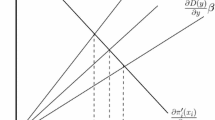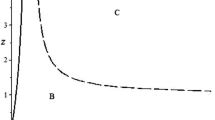Abstract
If a regulator is unable to measure firms’ individual emissions, an ambient tax can be used to achieve the socially desired level of pollution. With this tax, each firm pays a unit tax on aggregate emissions. In order for the tax to be effective, firms must recognize that their decisions affect aggregate emissions. When firms behave strategically with respect to the tax-setting regulator, under plausible circumstances their tax burden is lower under an ambient tax, relative to the tax which charges firms on the basis of individual emissions. Firms may prefer the case where the regulator is unable to observe individual firm emissions, even if this asymmetric information causes the regulator to tax each firm on the basis of aggregate emissions.
Similar content being viewed by others
References
R. Cabe J. Herriges (1992) ArticleTitle‘The Regulation of Non-Point Source Pollution under Imperfect and Asymmetric Information’ Journal of Environmental and Economic Management 22 IssueID2 134–146 Occurrence Handle10.1016/0095-0696(92)90010-T
J. Cremer (1995) ArticleTitle‘Arm’s Length Relationships’ Quarterly Journal of Economics 110 IssueID2 275–95 Occurrence Handle10.2307/2118440
H. Farzin J. D. Kaplan (1998) ‘Nonpoint Source Pollution Control Under Incomplete and Costly Information’ Department of Agricultural and Resource Economics, University of California Davis
D. Garvie A. Keeler (1994) ArticleTitle‘Incomplete Enforcement with Endogenous Regulatory Choice’ Journal of Public Economics 55 IssueID1 141–162 Occurrence Handle10.1016/0047-2727(94)90085-X
L. G. Hansen (1998) ArticleTitle‘A Damage-Based Tax Mechanism for Regulation of Non-Point Emissions’ Environmental and Resource Economics 12 99–112 Occurrence Handle10.1023/A:1008222900176
J. Herriges R. Govindasamy J. Shogren (1994) ArticleTitle‘Budget-Balancing Incentive Mechanisms’ Journal of Environmental Economics and Management 27 IssueID3 275–285 Occurrence Handle10.1006/jeem.1994.1039
B. Holmstrom (1982) ArticleTitle‘Moral Hazard in Teams’ Bell Journal of Economics 13 IssueID2 323–340 Occurrence Handle10.2307/3003457
R. D. Horan J. S. Shortle D. G. Abler (1998) ArticleTitle‘Ambient Taxes When Polluters have Multiple Choices’ Journal of Environmental Economics and Management 36 186–199 Occurrence Handle10.1006/jeem.1998.1041
R. D. Horan J. S. Shortle D. G. Abler (2002) ArticleTitle‘Ambient Taxes Under m-Dimensional Choice Sets, Heterogenous Expectations and Risk-Aversion’ Environmental and Resource Economics 21 189–202 Occurrence Handle10.1023/A:1014584418846
C. Hyde G. Rausser L. Simon (2000) ArticleTitle‘Regulating Multiple Polluters: Deterrence and Liability Allocation’ International Economic Review 41 495–521 Occurrence Handle10.1111/1468-2354.00073
L. Karp (1992) ArticleTitle‘The Endogenous Stability of Economic Systems: The Case of Many Agents’ Journal of Economic Dynamics and Control 16 117–138 Occurrence Handle10.1016/0165-1889(92)90009-4
L. Karp J. Livernois (1994) ArticleTitle‘Using Automatic Tax Changes to Control Pollution Emissions’ Journal of Environmental Economics and Management 27 38–48 Occurrence Handle10.1006/jeem.1994.1024
Liski, M. (1997), On the Regulation of Pollution and Polluters Long-Term Compliance Strategies’, PhD dissertation, Chapter 4, Helsinki School of Economics and Business Administration.
K. Millock F. Salanie (1998) ‘Nonpoint Source Pollution When Polluters Might Cooperate’ Department of Agriculture and Resource Economics, University of California Berkeley
K. Millock D. Sunding D. Zilberman (2002) ArticleTitle‘Regulating Pollution with Endogenous Monitoring’ Journal of Environmental Economics and Management 44 221–241 Occurrence Handle10.1006/jeem.2001.1208
W. Novshek H. Sonnenschein (1987) ArticleTitle‘General equilibrium with Free Entry: A Synthetic Approach to the Theory of Perfect Competition’ Journal of Economic Literature 25 IssueID3 1281–1306
E. Rasmusen (1987) ArticleTitle‘Moral Hazard in Risk-Averse Teams’ Rand Journal of Economics 18 IssueID3 428–435 Occurrence Handle10.2307/2555607
K. Segerson (1988) ArticleTitle‘Uncertainty and Incentives in Nonpoint Pollution Control’ Journal of Environmental Economics and Management 15 IssueID1 87–98 Occurrence Handle10.1016/0095-0696(88)90030-7
Segerson, K. (1997), ‘Flexible Incentives: A Unifying Framework for Policy Analysis’, Working Paper, University of Connecticut.
J. S. Shortle J. W. Dunn (1986) ArticleTitle‘The Relative Efficiency of Agricultural Source Water Pollution Control Variables’ American Journal of Agricultural Economics 68 668–677 Occurrence Handle10.2307/1241551
J. S. Shortle R. D. Horan D. G. Abler (1997) ArticleTitle‘Research Issues in Nonpoint Pollution Control’ Environmental and Resource Economics 11 IssueID3–4 571–585
S. Tsutsui K. Mino (1990) ArticleTitle‘Nonlinear Strategies in Dynamic Duopolistic Competition with Sticky Prices’ Journal of Economic Theory 52 136–161 Occurrence Handle10.1016/0022-0531(90)90071-Q
A. P. Xepapadeas (1991) ArticleTitle‘Environmental Policy under Imperfect Information: Incentives and Moral Hazard’ Journal of Environmental Economics and Management 20 IssueID2 113–126 Occurrence Handle10.1016/0095-0696(91)90045-K
A. P. Xepapadeas (1992) ArticleTitle‘Environmental Policy Design and Dynamic Nonpoint-Source Pollution’ Journal of Environmental Economics and Management 23 IssueID1 22–39 Occurrence Handle10.1016/0095-0696(92)90039-Y
Author information
Authors and Affiliations
Corresponding author
Rights and permissions
About this article
Cite this article
Karp, L. Nonpoint Source Pollution Taxes and Excessive Tax Burden. Environ Resource Econ 31, 229–251 (2005). https://doi.org/10.1007/s10640-005-1772-8
Accepted:
Issue Date:
DOI: https://doi.org/10.1007/s10640-005-1772-8




